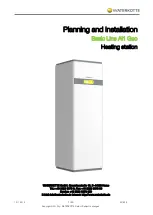
404
Thermo H plus
4 Functions of the heater
The purge cycle ends approx. after 120 seconds. The
combustion air fan is switched off.
The heater is in a controlled break.
The operation indicator is on.
Once the temperature falls short of the lower switching
threshold, the heater restarts burner operation. It runs
through the same sequence as the switching-on
sequence.
4.3.2.1 Auxiliary heating mode and parking heating
mode
From the terminal D+/+61 the control device receives the
information either the vehicle engine is running or not.
If the engine is running the heater is in the auxiliary
heating mode.
The switching thresholds are higher than in the parking
mode with the engine not running.
In the parking heating operation an economy mode may
be activated.
4.3.2.2 Economy circuit
If the economy circuit is activated (economy mode) the
controlled temperatures inthe heating system are main-
tained at a low temperature level. The lower and upper
switching threshold are reduced.
Due to lower radiation loss the fuel consumption can be
reduced for a lower heat demand (e.g. warmer mode).
The heater burner output is not reduced.
n auxiliary heating mode (signal from terminal D+/+61)
saving mode is automatically deactivated.
4.3.2.3 Gradient evaluation
In case of low coolant flow or poor coolant circuit venting
the temperature quickly increases in heating operation.
The control device recognises the quick temperature
increase and automatically sets the upper switching
threshold to a lower value.
The quicker the temperature increases, the lower the swit
-
ching threshold for starting the controlled break is set.
In addition, the burner is also switched back on again after
the controlled break at a lower switching threshold.
This prevents residual heat triggering the overheating
protection.
4.3.2.4 Minimum combustion period
NOTE:
Frequent burning time under 120 seconds may result in
soot build and increased smoke formation.
A minimum burner combustion period of 120 second is
targeted.
For ambient and operating conditions this target is not
always achieved.
In order to achieve the minimum combustion period, the
lower switching threshold is variably adjusted by the
control device.
This process is also called hysteresis adaptation and is
applied during each heating operation.
If the combustion period falls short of the minimum
combustion period of 120 seconds, the lower switching
value is lowered by 1K for the following combustion
process. The upper switching threshold remains as is.
This can be repeated until the minimum combustion
period is reached or the lower switching threshold is
reduced by 5K.
A further lowering is not possible.
Following a combustion process, where the required
minimum combustion period was reached, the lower swit
-
ching threshold is raised in steps of 1 K, max. up to the
initial level.
4.3.3 Switching off
Switching the heater off ends the combustion process.
The operation indicator goes out and and the purge cycle
is initiated.
The solenoid valve closes, the flame expires, the combu
-
stion air fan and the circulating pump continue running.
The purge cycle ends approx. after 120 seconds. The
combustion air fan is switched off.
If a malfunction occurs during purge cycle (e.g. flame
detection), the purge cycle may be shorter than 120
seconds.
During purge cycle it is permitted to switch the heater back
on. The burner will restart after a purge cycle time of 30
seconds and subsequent initial cycle time.
4.4
Diagnosis interface and (Diagnose
Thermo Test) DTT diagnosis
The D-heater supports diagnosis capabilities.
Using the DTT diagnosis adapter, DTT diagnosis and a
PC, the heaters in a vehicle can be checked.
Information on the hook-up of the heater to the DTT
diagnosis and its usage can be found in the DTT Opera
-
tion Instructions which are supplied with the device.
The Operation Instructions are also available for
on the Valeo website.
NOTE:
For protection against moisture and contamination ensure
that the diagnosis interface is sealed using a dummy plug,
if not in use.
Summary of Contents for Thermo H 160
Page 47: ...memos...
















































